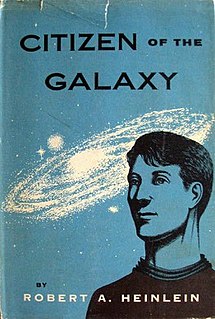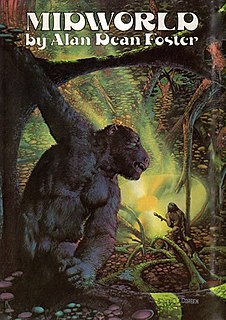
Citizen of the Galaxy is a science fiction novel by American writer Robert A. Heinlein, originally serialized in Astounding Science Fiction and published in hardcover in 1957 as one of the Heinlein juveniles by Scribner's. The story is heavily influenced by Rudyard Kipling's Kim.

Foundation and Earth is a science fiction novel by American writer Isaac Asimov, the fifth novel of the Foundation series and chronologically the last in the series. It was published in 1986, four years after the first sequel to the Foundation trilogy, which is titled Foundation's Edge.

Man of Two Worlds (1986) is a science fiction novel by American writers Brian and Frank Herbert.

Space Opera is a novel by the American science fiction author Jack Vance, first published in 1965.
Galaxy of Fear is a series of science fiction novels set in the Star Wars galaxy three years after Star Wars: Episode IV – A New Hope. The books are meant for younger readers. The books ranged from 100 pages to 200 pages in large print. The series of 12 books was written by John Whitman, and were released from February 1997 through to October 1998.

Cluster is a series of science fiction novels by Piers Anthony. Anthony originally conceived of and wrote the series as a trilogy but later added two additional volumes.

Midworld (1975) is a science fiction novel by American writer Alan Dean Foster. It is set in his primary science fiction universe, the Humanx Commonwealth.
The planetary systems of stars other than the Sun and the Solar System are a staple element in many works of the science fiction genre.
Death or Glory is a science fiction novel by Vladimir Vasilyev, first published in Russian in 1998, then translated into English in 2004 by Capricorn Publishing. The first part of Death or Glory may be read online.
The Hooded Swan series is a series of science fiction novels by Brian Stableford, published in the early 1970s, beginning with Halcyon Drift (1972). It consists of six books, which have also been collected in an omnibus entitled Swan Songs: The Complete Hooded Swan Collection (2001).

Aliens: Earth Hive is a 1992 novel by Steve Perry, set in the fictional Alien movie universe. It is an adaptation of the story "Outbreak" which was the first in the Aliens comic book series, written by Mark Verheiden.
Barrington J. Bayley was an English science fiction writer.

The Pillars of Eternity is the tenth novel by the science fiction author Barrington J. Bayley.

The Knights of the Limits is the first science fiction collection by Barrington J. Bayley. The book collects nine short stories published between 1965 and 1978, one of which is original to this volume.

Time and Again is a 1951 science fiction novel by American writer Clifford D. Simak. An alternate paperback title was First He Died; it was also serialized as Time Quarry.
The Marvel Cinematic Universe (MCU) is an American media franchise and shared universe centered on superhero films and other series starring various titular superheroes independently produced by Marvel Studios and based on characters that appear in American comic books published by Marvel Comics. The shared universe, much like the original Marvel Universe in comic books, was established by crossing over common plot elements, settings, cast, and characters. Due to the galaxy-spanning nature of the franchise, multiple species have been introduced.










